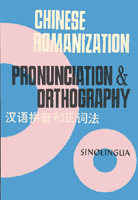 No, I’m not switching to French. I just wanted to get back to the matter of the particle le (了), which was discussed previously in How to write verbs in Hanyu Pinyin. Le is so frequently used that it deserves its own section.
No, I’m not switching to French. I just wanted to get back to the matter of the particle le (了), which was discussed previously in How to write verbs in Hanyu Pinyin. Le is so frequently used that it deserves its own section.
Because today’s selection on this from Chinese Romanization: Pronunciation and Orthography is just a few pages long, for this post I typed out all of it — other than most Chinese characters, which can be seen in the PDF of the original: Tense-Marking Particles (le/了) (240 KB PDF).
*****
9.2. Tense-Marking Particles
Tense-marking particles have already been discussed in some detail in Chapter 5, Verbs. It was noted there that the tense markers zhe (indicating an action in progress) and guo (indicating a past experience) are always written as a single unit with the verb they follow. The particle le 了 (indicating a completed action) is sometimes, but not always, written as a single unit with its verb. This is because le, unlike zhe and guo, may be separated from its verb by other elements; and also because le itself can act as a mood particle as well as a tense particle. (For details on le as a mood particle, see Section 3 of chapter 9.)
This section is devoted to a discussion of orthography specifically as it relates to the tense particle le. Three rules are laid out to help the student master the written forms of this particle.
- When le occurs in the middle of a sentence or phrase, and immediately follows a verb or verb construction written as a single unit, le is written together with that verb or verb construction:
- kànle yī chǎng diànyǐng (saw a movie)
- tǎolùnle xǔduō wèntí (discussed many issues)
- chīwánle píngguǒ he xiāngjiāo (finished off the apples and bananas)
- dǎsǐle sān zhī tùzi (shot three rabbits)
- When le occurs in the middle of a sentence or phrase, and follows a verb phrase written as two or more units, then le is written separately:
- zǒu jìnlai le yī wèi jiāngjūn (a general came in)
- shōushi hǎo le zìjǐ de xíngli (gathered up one’s luggage)
- dǎsǎo gānjìng le zhè jiān shūfáng (cleaned up the study)
- yánjiū bìng jiějué le huánjìng wūrǎn de wèntí (researched and solved the problem of environmental pollution)
- Note that le here applies to both verbs, so that the meaning is equivalent to yánjiūle bìng jiějuéle.
- When le occurs at the end of a phrase or sentence (that is, immediately before any form of punctuation), it is written separately from other elements:
- Xiàtiān lái le. (Summer is here.)
- Wǒmen fàngle jià le. (Our vacation has begun.)
- Kělián de xiǎoyáng, bèi láng gěi chīdiào le. (The poor little lamb was eaten up by the wolf.)
- Tiān kuài liàng le, wǒmen gāi dòngshēn le. (It’s almost dawn; we should get moving.)
- Hǎo le, hǎo le, nímen zài bùyào zhēnglùn le. (All right, stop arguing, all of you.)
- Nǐ bù shì chīguo fàn le ma? (Haven’t you eaten already?)
- Note that le is here treated as if it occupied the sentence-final position, despite the presence of another particle (ma) following it.
*****
OK, it’s me again. In closing I want to draw attention to that final note, because it’s important: If le is followed by ma, le is still treated as if it came at the end of the sentence and thus is written separately from its verb.
